厦门大学:《结构化学 Structural Chemistry》课程教学资源(电子教案)Chapter 03 Molecular symmetry and symmetry point group

Chapter 3 Molecular symmetry and symmetry point group 1 Symmetry elements and symmetry operations >Symmetry exists all around us and many people see it as being a thing of beauty. >A symmetrical object contains within itself some parts which are equivalent to one another. >The systematic discussion of symmetry is called Some objects are more symmetrical than others
Chapter 3 Molecular symmetry and symmetry point group §1 Symmetry elements and symmetry operations ¾Symmetry exists all around us and many people see it as being a thing of beauty. ¾A symmetrical object contains within itself some parts which are equivalent to one another. ¾The systematic discussion of symmetry is called : Some objects are more symmetrical than others
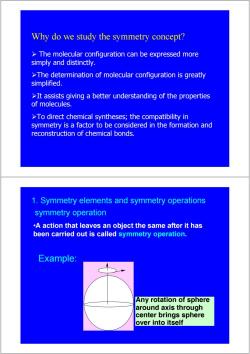
Why do we study the symmetry concept? >The molecular configuration can be expressed more simply and distinctly. >The determination of molecular configuration is greatly simplified. >It assists giving a better understanding of the properties of molecules. >To direct chemical syntheses;the compatibility in symmetry is a factor to be considered in the formation and reconstruction of chemical bonds. 1.Symmetry elements and symmetry operations symmetry operation .A action that leaves an object the same after it has been carried out is called symmetry operation. Example: Any rotation of sphere around axis through center brings sphere over into itself
¾ The molecular configuration can be expressed more simply and distinctly. ¾The determination of molecular configuration is greatly simplified. ¾It assists giving a better understanding of the properties of molecules. ¾To direct chemical syntheses; the compatibility in symmetry is a factor to be considered in the formation and reconstruction of chemical bonds. Why do we study the symmetry concept? symmetry operation •A action that leaves an object the same after it has been carried out is called symmetry operation. Any rotation of sphere around axis through center brings sphere over into itself Example: 1. Symmetry elements and symmetry operations
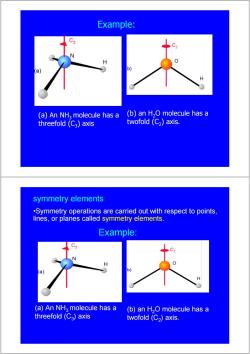
Example: (a)An NH2 molecule has a (b)an H2O molecule has a threefold (C3)axis twofold (C)axis. symmetry elements .Symmetry operations are carried out with respect to points, lines,or planes called symmetry elements. Example: (a)An NHa molecule has a (b)an H2O molecule has a threefold(Ca)axis twofold (C2)axis
(b) an H2O molecule has a twofold (C2) axis. (a) An NH3 molecule has a threefold (C3) axis Example: (b) an H2O molecule has a twofold (C2) axis. (a) An NH3 molecule has a threefold (C3) axis Example: •Symmetry operations are carried out with respect to points, lines, or planes called symmetry elements. symmetry elements
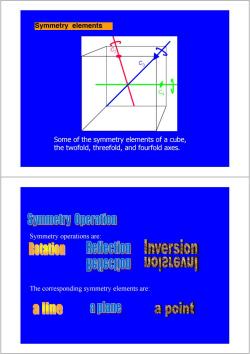
Symmetry elements 03 Some of the symmetry elements of a cube, the twofold,threefold,and fourfold axes. Symmetry Operation Symmetry operations are: Rotation Reflection nversion 60I UOI2LSAUI The corresponding symmetry elements are: aa如e a point
Some of the symmetry elements of a cube, the twofold, threefold, and fourfold axes. Symmetry elements Symmetry operations are: The corresponding symmetry elements are:
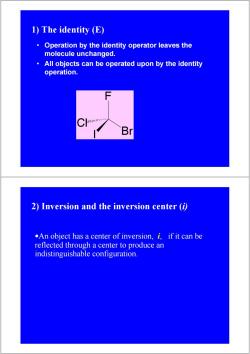
1)The identity (E) Operation by the identity operator leaves the molecule unchanged. All objects can be operated upon by the identity operation. Br 2)Inversion and the inversion center (i) .An object has a center of inversion,i,if it can be reflected through a center to produce an indistinguishable configuration
I F Cl Br • Operation by the identity operator leaves the molecule unchanged. • All objects can be operated upon by the identity operation. 1) The identity (E) 2) Inversion and the inversion center (i) •An object has a center of inversion, i, if it can be reflected through a center to produce an indistinguishable configuration

For example F 0=C=0 S. These have a center of inversion i. H H These do not have a center of inversion. >Inverts all atoms through the centre of the object 1 6 Inversion 5 30 03 Center of inversion 6 >Its matrix representation -1 0 0 0 0 -x 0 -1 0 0 -1 0 y 0 0 -1 0 0
These do not have a center of inversion. These have a center of inversion i. For example ⎟ ⎟ ⎟ ⎠ ⎞ ⎜ ⎜ ⎜ ⎝ ⎛ − − − 0 0 1 0 1 0 1 0 0 ⎟ ⎟ ⎟ ⎠ ⎞ ⎜ ⎜ ⎜ ⎝ ⎛ − − − = ⎟ ⎟ ⎟ ⎠ ⎞ ⎜ ⎜ ⎜ ⎝ ⎛ ⎟ ⎟ ⎟ ⎠ ⎞ ⎜ ⎜ ⎜ ⎝ ⎛ − − − = ⎟ ⎟ ⎟ ⎠ ⎞ ⎜ ⎜ ⎜ ⎝ ⎛ z y x z y x z y x i 0 0 1 0 1 0 1 0 0 ¾Its matrix representation ¾Inverts all atoms through the centre of the object

3)Rotation and the n-fold rotation axis(C) Rotation about an n-fold axis (rotation through 360/n) is denoted by the symbol Cn. Example:Rotation of trigonal planer BFa 120°rotation 120°rotation F → B C3 -One three-fold(C3)rotation axes. (a=2元/3) The principle rotation axis is the axis of the highest fold The principle rotation axis is the axis of the highest fold. H
• Example: Rotation of trigonal planer BF3 C3 1 C3 2 Rotation about an n-fold axis (rotation through 360o/n) is denoted by the symbol Cn. 3) Rotation and the n-fold rotation axis (Cn) The principle rotation axis is the axis of the highest fold. –One three-fold (C3) rotation axes. (α=2π/3) C5 The principle rotation axis is the axis of the highest fold. C6
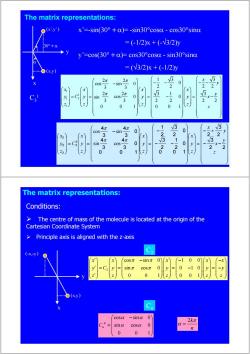
The matrix representations: o(xy) x'=-sin(30°+a)=-sin30°cosa-cos30°sina 30°+a =(-1/2)x+(-V3/2y y'=cos(30°+)=cos30°cosa-sin30°sind =(V3/2)x+(-1/2y (xy) 2π 2π 1 5 cos -sin 0 0 3 3 25 2 2 2 2 x x A N 2π sin 3 cos 3 0 y 0 x-x 2 2 y 0 0 0 0 1 4π 4π 1 3 3 cos sin 0 0 x 4 3 23 2 2 sin cos 0 0 x- 3 3 -20 y 2 2 z 0 0 1 1 The matrix representations: Conditions: > The centre of mass of the molecule is located at the origin of the Cartesian Coordinate System Principle axis is aligned with the z-axis C2 -snπ 0 0) -x sin 0 0 0 1 0 )(xy) cosa -sina 0 2kπ sin a cosa 0 0 0
The matrix representations: 30°+α α (x,y) (x’,y’) C3 1 x y x’=-sin(30°+α)= -sin30°cosα - cos30°sinα = (-1/2)x + (-√3/2)y y’=cos(30°+α)= cos30°cosα - sin30°sinα = (√3/2)x + (-1/2)y ⎟ ⎟ ⎟ ⎟ ⎟ ⎟ ⎟ ⎠ ⎞ ⎜ ⎜ ⎜ ⎜ ⎜ ⎜ ⎜ ⎝ ⎛ − − − + = ⎟ ⎟ ⎟ ⎠ ⎞ ⎜ ⎜ ⎜ ⎝ ⎛ ⎟ ⎟ ⎟ ⎟ ⎟ ⎟ ⎟ ⎠ ⎞ ⎜ ⎜ ⎜ ⎜ ⎜ ⎜ ⎜ ⎝ ⎛ − − − = ⎟ ⎟ ⎟ ⎠ ⎞ ⎜ ⎜ ⎜ ⎝ ⎛ ⎟ ⎟ ⎟ ⎟ ⎟ ⎟ ⎠ ⎞ ⎜ ⎜ ⎜ ⎜ ⎜ ⎜ ⎝ ⎛ − = ⎟ ⎟ ⎟ ⎠ ⎞ ⎜ ⎜ ⎜ ⎝ ⎛ = ⎟ ⎟ ⎟ ⎠ ⎞ ⎜ ⎜ ⎜ ⎝ ⎛ z y x y x z y x z y x z y x C z y x 2 2 3 2 3 2 0 0 1 0 2 1 2 3 0 2 3 2 1 0 0 1 0 3 4 3 4 0 3 4 3 4 2 3 2 2 2 π π π π sin cos cos sin 1 1 1 3 1 2 2 13 3 cos sin 0 0 3 3 2 2 22 2 2 31 3 cos cos 0 0 3 3 2 2 22 0 01 0 01 x y xx x x y y Cy y y x zz z z z π π π π ⎛ ⎞⎛ ⎞ ⎛ ⎞ − ⎜ ⎟⎜ ⎟ − − −− ⎜ ⎟ ⎛ ⎞ ⎛⎞ ⎛⎞ ⎛⎞ ⎜ ⎟ ⎜⎟ ⎜⎟ ⎜⎟ == = − =− ⎝ ⎠ ⎝⎠ ⎝⎠ ⎝⎠ ⎝ ⎠ ⎝ ⎠⎝ ⎠ sin ⎟ ⎟ ⎟ ⎠ ⎞ ⎜ ⎜ ⎜ ⎝ ⎛ − = 0 0 1 sin cos 0 cos sin 0 α α α α k Cn n kπ α 2 = 2 cos sin 0 1 0 0 sin cos 0 0 1 0 0 0 1 0 01 x x x xx y Cy y y y z z z zz π π π π ⎛ ⎞ ⎛ ⎞ ⎛ ⎞⎛ ⎞ ⎛ ⎞⎛ ⎞ ⎛ ⎞ ′ − − − ⎜ ⎟ ⎜ ⎟ ⎜ ⎟⎜ ⎟ ⎜ ⎟⎜ ⎟ ⎜ ⎟ ′ = = = − =− ′ ⎝ ⎠ ⎝ ⎠ ⎝ ⎠⎝ ⎠ ⎝ ⎠⎝ ⎠ ⎝ ⎠ The matrix representations: C2 Cn (x,y) (-x,-y) x y Conditions: ¾ The centre of mass of the molecule is located at the origin of the Cartesian Coordinate System ¾ Principle axis is aligned with the z-axis
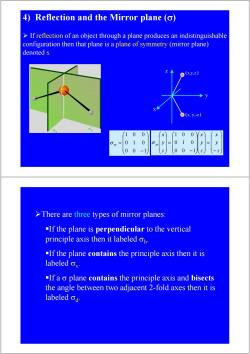
4)Reflection and the Mirror plane (o) >If reflection of an object through a plane produces an indistinguishable configuration then that plane is a plane of symmetry (mirror plane) denoted s. (x.y,-Z 6对 0 0 >There are three types of mirror planes: -If the plane is perpendicular to the vertical principle axis then it labeled on -If the plane contains the principle axis then it is labeled ov. -If a o plane contains the principle axis and bisects the angle between two adjacent 2-fold axes then it is labeled od
¾ If reflection of an object through a plane produces an indistinguishable configuration then that plane is a plane of symmetry (mirror plane) denoted s. 4) Reflection and the Mirror plane (σ) ⎟ ⎟ ⎟ ⎠ ⎞ ⎜ ⎜ ⎜ ⎝ ⎛ − = 0 0 1 0 1 0 1 0 0 σ xy ⎟ ⎟ ⎟ ⎠ ⎞ ⎜ ⎜ ⎜ ⎝ ⎛ − = ⎟ ⎟ ⎟ ⎠ ⎞ ⎜ ⎜ ⎜ ⎝ ⎛ ⎟ ⎟ ⎟ ⎠ ⎞ ⎜ ⎜ ⎜ ⎝ ⎛ − = ⎟ ⎟ ⎟ ⎠ ⎞ ⎜ ⎜ ⎜ ⎝ ⎛ z y x z y x z y x xy 0 0 1 0 1 0 1 0 0 σ (x, y,-z) z (x,y,z) y x ¾There are three types of mirror planes: If the plane is perpendicular to the vertical principle axis then it labeled σh. If the plane contains the principle axis then it is labeled σv. If a σ plane contains the principle axis and bisects the angle between two adjacent 2-fold axes then it is labeled σd
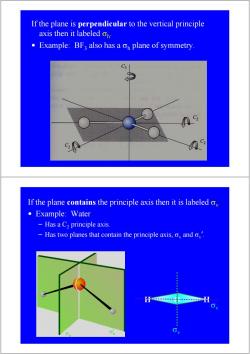
If the plane is perpendicular to the vertical principle axis then it labeled oh Example:BF3 also has a on plane of symmetry C3 9 C2 If the plane contains the principle axis then it is labeled o ● Example:Water Has a C2 principle axis. Has two planes that contain the principle axis,o,and o,. 6
If the plane is perpendicular to the vertical principle axis then it labeled σh. • Example: BF3 also has a σh plane of symmetry. If the plane contains the principle axis then it is labeled σv. • Example: Water – Has a C2 principle axis. – Has two planes that contain the principle axis, σv and σv ’. H H O σv σv
按次数下载不扣除下载券;
注册用户24小时内重复下载只扣除一次;
顺序:VIP每日次数-->可用次数-->下载券;
- 厦门大学:《结构化学 Structural Chemistry》课程教学资源(电子教案)Chapter 02 The structure and properties of atoms.pdf
- 厦门大学:《结构化学 Structural Chemistry》课程教学资源(电子教案)Chapter 01 The basic knowledge of quantum mechanics.pdf
- Chemcal Reviews:Classical Valence Bond Approach by Modern Methods.pdf
- Nature Chemistry:Quadruple bonding in C2 and analogous eight-valence electron species.pdf
- 化学品毒性鉴定技术规范(2005年6月).pdf
- 运城学院:《分析化学 Analytical Chemistry》课程教学资源(课后习题)第八章 吸光光度法(含答案).docx
- 运城学院:《分析化学 Analytical Chemistry》课程教学资源(课后习题)第七章 重量分析法(含答案).docx
- 运城学院:《分析化学 Analytical Chemistry》课程教学资源(课后习题)第六章 沉淀滴定法(含答案).docx
- 运城学院:《分析化学 Analytical Chemistry》课程教学资源(课后习题)第四章 络合滴定法(含答案).docx
- 运城学院:《分析化学 Analytical Chemistry》课程教学资源(课后习题)第五章 氧化还原滴定(含答案).docx
- 运城学院:《分析化学 Analytical Chemistry》课程教学资源(课后习题)第三章 酸碱滴定法(含答案).docx
- 运城学院:《分析化学 Analytical Chemistry》课程教学资源(课后习题)第二章 分析化学中的误差与数据处理(含答案).docx
- 运城学院:《分析化学 Analytical Chemistry》课程教学资源(课后习题)第一章 绪论(含答案).docx
- 运城学院:《分析化学 Analytical Chemistry》课程教学资源(试卷习题)期末试题(试卷)C(含答案).docx
- 运城学院:《分析化学 Analytical Chemistry》课程教学资源(试卷习题)期末试题(试卷)B(含答案).docx
- 运城学院:《分析化学 Analytical Chemistry》课程教学资源(试卷习题)期末试题(试卷)A(含答案).docx
- 西北大学:《分析化学 Analytical Chemistry》课程教学资源(考研真题)2022年分析化学考研真题.pdf
- 西北大学:《分析化学 Analytical Chemistry》课程教学资源(考研真题)2021年分析化学考研真题.pdf
- 西北大学:《分析化学 Analytical Chemistry》课程教学资源(考研真题)2020年分析化学考研真题.pdf
- 西北大学:《分析化学 Analytical Chemistry》课程教学资源(考研真题)2019年分析化学考研真题.pdf
- 厦门大学:《结构化学 Structural Chemistry》课程教学资源(电子教案)Chapter 04 The structure of diatomic molecules.pdf
- 厦门大学:《结构化学 Structural Chemistry》课程教学资源(电子教案)Chapter 05 The structure of polyatomic molecules.pdf
- 厦门大学:《结构化学 Structural Chemistry》课程教学资源(电子教案)Chapter 06 The polyatomic molecules.pdf
- 厦门大学:《结构化学 Structural Chemistry》课程教学资源(电子教案)Chapter 07 Introduction to Crystallography.pdf
- 厦门大学:《结构化学 Structural Chemistry》课程教学资源(电子教案)Chapter 08 The structures and properties of metals and alloys.pdf
- 厦门大学:《结构化学 Structural Chemistry》课程教学资源(电子教案)Chapter 09 Structural chemistry of ionic compounds.pdf
- 《生命的化学》:混合学习在基础生物化学应用中的效果分析(甘肃农业大学:唐勋,张宁,周香艳,吴兵,王旺田,王翠玲,杨德龙).pdf
- 甘肃农业大学:《生物化学》课程教学资源(课件讲稿)第十二章 蛋白质的生物合成 Protein Synthesis.pdf
- 甘肃农业大学:《生物化学》课程教学资源(课件讲稿)第二章 核酸 nucleic acids(主讲:张宁).pdf
- 甘肃农业大学:《生物化学》课程教学资源(课件讲稿)第七章 生物氧化与氧化磷酸化 Biological Oxidation & Oxidative Phosphorylation.pdf
- 甘肃农业大学:《生物化学》课程教学资源(课件讲稿)第九章 蛋白质的酶促降解和氨基酸代谢 Degradation of protein and metabolism of amino acid.pdf
- 甘肃农业大学:《基础生物化学》课程教学资源(课件讲稿)第一章 绪论 Fundamental Biochemistry(主讲:张宁).pdf
- 湖南大学:《基础无机化学实验》课程教学资源(教学大纲)Inorganic Chemistry Experiment.doc
- 湖南大学:《基础物理化学实验》课程教学资源(教学大纲)2018教学大纲基础物理化学实验(A)Physical Chemistry Experiment(化工).doc
- 湖南大学:《基础物理化学实验》课程教学资源(教学大纲)2018教学大纲基础物理化学实验(1)Physical Chemistry Experiment(化学、应化).doc
- 湖南大学:《基础物理化学实验》课程教学资源(教学大纲)2018教学大纲基础物理化学实验(2)Physical Chemistry Experiment(化学、应化).doc
- 湖南大学:《基础化学实验》教课程教学资源(教学大纲)2018基础化学实验教学大纲(环科综合)Basic Chemistry Experiment.doc
- 湖南大学:化学化工学院本科专业(2018 版)课程教学大纲合集汇编4(学门、学类核心课、选修、通识选修).doc
- 湖南大学:化学化工学院本科专业(2018 版)课程教学大纲合集汇编1(学类核心、专业课、选修课).doc
- 湖南大学:化学化工学院本科专业(2018 版)课程教学大纲合集汇编2(应用化学).doc
